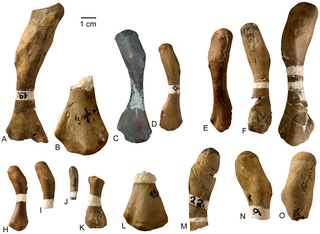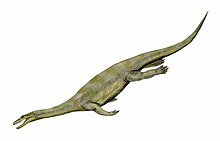
Dinocephalosaurus is a genus of long necked, aquatic protorosaur that inhabited the Triassic seas of China. The genus contains the type and only known species, D. orientalis, which was named by Chun Li in 2003. Unlike other long-necked protorosaurs, Dinocephalosaurus convergently evolved a long neck not through elongation of individual neck vertebrae, but through the addition of neck vertebrae that each had a moderate length. As indicated by phylogenetic analyses, it belonged in a separate lineage that also included at least its closest relative Pectodens, which was named the Dinocephalosauridae in 2021. Like tanystropheids, however, Dinocephalosaurus probably used its long neck to hunt, utilizing the fang-like teeth of its jaws to ensnare prey; proposals that it employed suction feeding have not been universally accepted. It was probably a marine animal by necessity, as suggested by the poorly-ossified and paddle-like limbs which would have prevented it from going ashore.

Nothosaurs were Triassic marine sauropterygian reptiles. They averaged about 3 metres (10 ft) in length, with a long body and tail. The feet were paddle-like, and are known to have been webbed in life, to help power the animal when swimming. The neck was quite long, and the head was elongated and flattened, and relatively small in relation to the body. The margins of the long jaws were equipped with numerous sharp outward-pointing teeth, indicating a diet of fish and squid.

Placodonts are an extinct order of marine reptiles that lived during the Triassic period, becoming extinct at the end of the period. They were part of Sauropterygia, the group that includes plesiosaurs. Placodonts were generally between 1 and 2 m in length, with some of the largest measuring 3 m (9.8 ft) long.

Lariosaurus is an extinct genus of nothosaurid from the Middle Triassic of central and western Europe and China. With a complete specimen of L. xingyiensis measuring 70.5 cm (2.3 ft) long and L. hongguoensis possibly measuring up to 80 cm (2.6 ft) long, it was one of the smallest known nothosaurs. First discovered at Perledo on the Lake Como in 1830, it was named in 1847 by Curioni, its name meaning "Lizard from Larius", the ancient name of the lake. This makes it one of the earliest studied reptiles from the Alps. It is known from an almost complete skeleton holotype and several other fairly complete fossils.

Ceresiosaurus is an extinct aquatic genus of lariosaurine nothosaurid sauropterygian known from the Middle Triassic of Monte San Giorgio, southern Switzerland and northern Italy. Ceresiosaurus, meaning "Lizard of Ceresio". The type species, Ceresiosaurus calcagnii, was named by Bernhard Peyer in 1931. C. calcagnii is known from both the Cava superiore and Cava inferiore beds of the Lower Meride Limestone at Monte San Giorgio, dating to the latest Anisian of the Middle Triassic. Rieppel (1998) suggested that the back then monospecific genus Ceresiosaurus, is a junior synonym of the better known Lariosaurus, yet he kept it type species as a separate species under the new combination L. calcagnii. In 2004, however, this synonymy was objected by Hänni who described and name a second species of Ceresiosaurus, C. lanzi - a separation supported by several other authors since. This species is known only from the stratigraphically younger Cassima beds of Monte San Giorgio, although also from the Lower Meride Limestone, dating to possibly the lowest Ladinian age. The species in a subtropical lagoonal environment with varying open marine influences, and alongside many related but smaller species of nothosaurids and pachypleurosaurids. Ceresiosaurus represents one of the largest vertebrate of up to 3 m (9.8 ft) snout-tail length from the very diversified paleoenvironment of the Middle Triassic Monte San Giorgio.

Pistosaurus is an extinct genus of aquatic sauropterygian reptile closely related to plesiosaurs. Fossils have been found in France and Germany, and date to the Middle Triassic. It contains a single species, Pistosaurus longaevus. Pistosaurus is known as the oldest "subaquatic flying" reptile on earth.

Anarosaurus is an extinct genus of pachypleurosaurs that lived in the Middle Triassic period (Anisian) and has been found in the Jena Formation and the Karlstadt Formation of Germany and the Winterswijk Quarry of The Netherlands. Two species are known: A. pumilio and A. heterodontus. The holotype of A. pumilio was originally housed at the Institut und Museum fur Geologie und Palaontologie, Georg-August-Universitat, Gottingen, but can no longer be located today because it was lost or destroyed during World War II. Anarosaurus was a small reptile with an estimated body length of 50–60 cm (1.6–2.0 ft).
Dactylosaurus is a genus of nothosaur in the family Pachypleurosauridae. Along with Anarosaurus, Dactylosaurus was one of the earliest known pachypleurosaurs to come from Europe.

Cymatosaurus is an extinct genus of pistosauroid or nothosauriform sauropterygian. It is known to have been alive from the Early Triassic to the Middle Triassic period of Germany and they seem to originate from the Netherlands. It was small to medium-sized for an eosauropterygian, measuring 1–1.2 metres (3.3–3.9 ft) long.

Nothosauridae are an extinct family of carnivorous aquatic sauropterygian reptiles from the Triassic time period of China, France, Germany, Israel, Italy, Netherlands, Russia, Switzerland, and northern Africa.

Simosaurus is an extinct genus of marine reptile within the superorder Sauropterygia from the Middle Triassic of central Europe. Fossils have been found in deposits in France and Germany that are roughly 230 million years old. It is usually classified as a nothosaur, but has also been considered a pachypleurosaur or a more primitive form of sauropterygian.

Sinosaurosphargis is an extinct genus of basal marine saurosphargid reptile known from the Middle Triassic Guanling Formation of Yunnan and Guizhou Provinces, southwestern China. It contains a single species, Sinosaurosphargis yunguiensis.

Wumengosaurus is an extinct aquatic reptile from the Middle Triassic Guanling Formation of Guizhou, southwestern China. It was originally described as a basal eosauropterygian and usually is recovered as such by phylogenetic analyses, although one phylogeny has placed it as the sister taxon to Ichthyosauromorpha while refraining from a formal re-positioning. It was a relatively small reptile, measuring 95.5–130.5 cm (3.13–4.28 ft) in total body length.
Largocephalosaurus is an extinct genus of basal saurosphargid, a marine reptile known from the Middle Triassic Guanling Formation of Yunnan and Guizhou Provinces, southwestern China. It contains a type species, Largocephalosaurus polycarpon, and a second species L. qianensis.
Hanosaurus is an extinct genus of marine reptiles that existed during the Triassic period in what is now China. The type species is Hanosaurus hupehensis. It was a small animal, with specimens measuring 79.4 cm (31.3 in) long in total body length, which likely fed on soft-bodied prey.

The Erfurt Formation, also known as the Lower Keuper, is a stratigraphic formation of the Keuper group and the Germanic Trias supergroup. It was deposited during the Ladinian stage of the Triassic period. It lies above the Upper Muschelkalk and below the Middle Keuper.

Blezingeria is an extinct genus of marine reptile from the Middle Triassic of Germany. The type and only species Blezingeria ichthyospondyla was named by German paleontologist Eberhard Fraas in 1896. It is known from many isolated bones that come from a deposit in southwestern Germany called the Upper Muschelkalk, which dates back to the Ladinian stage. The relationships of Blezingeria are uncertain. Fraas identified it as a nothosaur, but it has also been classified as a cymbospondylid ichthyosaur, and most recently a thalattosaur. Many thalattosaur fossils have been found in a slightly olderLate Ladinian-age rock unit in Monte San Giorgio, Switzerland, so if Blezingeria is a thalattosaur, it may represent an early stage in an evolutionary radiation of the group across the Tethys, an ocean that covered much of what is now Europe and southern China during the Triassic. However, since Blezingeria is known from very incomplete material, its classification as a thalattosaur remains uncertain.

Silvestrosaurus is an extinct aquatic genus of lariosaurine nothosaurid sauropterygian known from the Middle Triassic of Monte San Giorgio, southern Switzerland. It contains a single species, Silvestrosaurus buzzii, originally considered to be a species of the closely related Lariosaurus. The species was named by Tschanz in 1989, based solely on the holotype PIMUZ T/2804 comprising the skull, the lower jaw, and a dis-articulated partial postcranial skeleton. Cyamodus hildegardis tooth bearing elements were found in the stomach region of the specimen. The holotype was collected at Punkt 902 of Monte San Giorgio, from layer 97 of the Grenzbitumen zone, dating to the Anisian-Ladinian boundary of the Middle Triassic. Kuhn-Schnyner (1990) reassigned the species to its own genus, creating the combination S. buzzii. The generic name honors a church near the collection locality of the holotype, dedicated to Saint Sylvester, a Pope during the reign of Constantine the Great, and from Greek saurus, meaning "lizard", a common suffix for genus names of extinct reptile.

Saurosphargidae is an extinct family of marine reptiles known from the Early Triassic and early Middle Triassic of Europe and China.
The Zhuganpo Formation is a Triassic geologic unit found in southern China. It has historically been known as the Zhuganpo Member of the Falang Formation. A diverse fossil assemblage known as the Xingyi biota or Xingyi Fauna can be found in the upper part of the Zhuganpo Formation. Fossils of the Xingyi biota include articulated skeletons of marine reptiles, abundant fish, and a plentiful assortment of invertebrates indicating a Ladinian to Carnian age for the sediments of the formation.

























